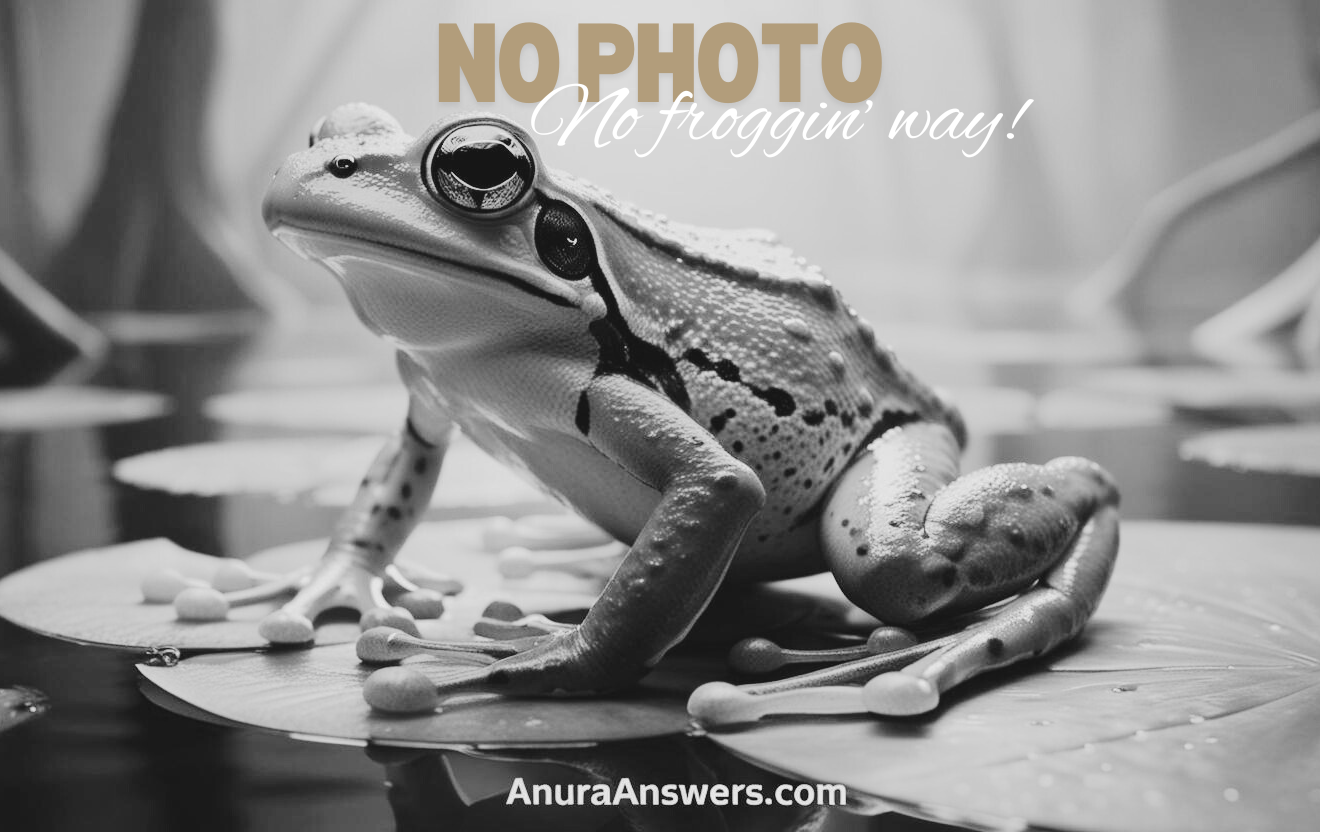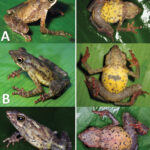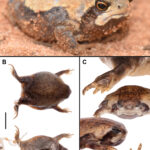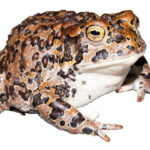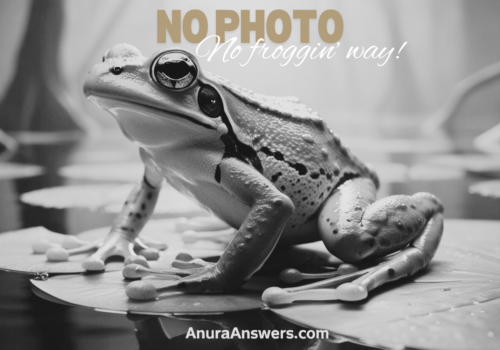Atelopus longibrachius: Unveiling the Secrets of a Rare Harlequin Frog#
In the vibrant rainforest shadows, hidden among damp leaf litter and flourishing mosses, thrives an extraordinary little creature whose survival dances on the brink of existence. Meet Atelopus longibrachius, a species of harlequin frog whose delicate demeanor belies the importance it holds in maintaining ecological balance amidst Ecuador’s teeming forests. Commonly known for their striking colors and slender limbs, harlequin frogs enchant naturalists while reminding us how intricately life is interconnected, vulnerable, and invaluable.
Yet, there is far more to these frogs than meets the eye. Beneath their striking appearance and compelling behaviors lies a species shaped by evolution, expertly adapted to its environment and quietly fighting for survival in an era of ecological upheaval. Join us as we explore the fascinating natural history and conservation journey of Atelopus longibrachius, highlighting why this small amphibian embodies the very essence of biodiversity and environmental responsibility.
Taxonomy and Classification#
Atelopus longibrachius belongs to the family Bufonidae, a distinctive group in the diverse order Anura that comprises true frogs and toads. Within this family, the genus Atelopus encompasses the brightly colored harlequin frogs, recognized for their stunning visual appeal matched by their often vulnerable conservation status. Atelopus frogs are particularly intriguing to researchers due to their exceptional sensitivity to environmental shifts, making them integral indicators of habitat health.
Closely related species within the Atelopus genus, such as the iconic Costa Rican golden toad (Atelopus zeteki), share striking similarities with A. longibrachius, yet each has adapted uniquely to the microclimates and challenges presented by their individual habitats. Often regarded as sentinels of climate change and habitat integrity, these frogs hold a prominent position in herpetological research and ecological conservation.
Natural Habitat#
Found predominantly within Ecuador’s lush tropical forests, Atelopus longibrachius has a range limited to humid, montane environments primarily along the western slopes of the Andes. These regions, characterized by dense vegetation, flowing freshwater streams, and persistent cloud coverage, forge the perfect sanctuary for harlequin frogs, providing both ideal moisture levels essential for amphibian life and abundant prey necessary for their sustenance.
This frog thrives predominantly near clear, oxygen-rich streams coursing gently through montane cloud forests. Often spotted perched upon rocks, logs, or leaf litter near shallow, crystalline water, these creatures live a semi-aquatic existence intimately bound to freshwater resources. Moss-covered boulders, tangled roots crumbling down steep embankments, and velvety carpets of moss and leaf litter contribute vital microhabitats offering humidity, protection from predators, and abundant food sources.
For Atelopus longibrachius, habitat plays a dual role—providing a refuge against predators through natural camouflage complements of its vibrant coloration and offering an abundant source of nourishment and breeding locations essential for continuation of the species. Such symbiosis with forest elements highlights just how intrinsically interconnected harlequin frogs are to their ecosystem.
Physical Characteristics#
One glimpse at Atelopus longibrachius immediately reveals the reason behind its reputation as an enchanting rainforest denizen. The species typically measures around 2 to 3 centimeters from snout to vent, placing it among smaller amphibians within the genus. Despite its diminutive stature, the visual impact of its form remains undeniably impressive.
Characterized by notably elongated limbs—an adaptation perfectly suited to its mountainous habitat—this frog climbs agilely across rocks and vegetation. Its slender legs serve the dual purpose of facilitating graceful leaps away from danger and deftly capturing prey. The frog’s feet display well-defined toe pads, specializing in gripping slippery surfaces near the stream edges.
The visually arresting coloration is another hallmark trait of A. longibrachius. Combining vibrant greens and yellows laced with intricate patterns of black or brown, the frog embodies natural symmetry and elegance. However, far from a mere aesthetic adaptation, its colors serve as a conspicuous warning to predators: Atelopus longibrachius secretes a mild toxin from glands beneath its skin, a subtle defense mechanism against would-be attackers, effectively broadcasting its unpalatability.
Behavior and Life Cycle#
Atelopus longibrachius follows a surprisingly intricate lifecycle laden with fascinating behaviors and rituals. Primarily diurnal, these frogs spend daylight hours basking near streams, engaging in hunting activities, territorial defense, and courtship displays. Harlequin frogs primarily subsist on a diet comprised of small insects, including ants, flies, mites, and beetles, skillfully capturing prey with a rapid, sticky tongue protrusion technique honed by millions of years of evolutionary refinement.
Breeding Biology: A Symphony in the Rainforest#
Perhaps most fascinatingly, during the rainy season—a critical period marking prime breeding conditions—a captivating symphony erupts around the riverbanks. Male frogs vocalize distinctively, projecting high-pitched trills or soft, melodious calls, intended to attract potential mates and establish dominance over suitable breeding grounds. Territorial males may engage in vocal contests or even physical engagements, attempting to secure the prime reproductive staging sites.
Once paired, elaborate amplexus occurs—the male confidently clasping the female from behind, remaining closely attached until she releases her gelatinous strings of eggs into the shallow stream waters. Here, aquatic currents gently cradle their precious cargo, transporting eggs to nutrient-rich microhabitats ideal for ensuing developmental stages.
Tadpoles soon hatch, equipped with rounded, streamlined forms designed impeccably for aquatic life. Over several weeks, these tiny larvae graze algae and micro-organisms along submerged surfaces. Their successful transition from aquatic to terrestrial environments symbolizes profound adaptation and resilience, echoing an evolutionary narrative as old as the forest itself.
Ecological Role#
The ecological importance of Atelopus longibrachius stretches far beyond individual curiosity or aesthetic appreciation. These frogs serve vital roles as both predator—controlling insect populations and contributing to healthy forest dynamics—and prey species themselves, supporting higher trophic organisms such as birds, reptiles, and mammals.
Because of their notable sensitivity to environmental shifts, harlequin frogs, including A. longibrachius, have become crucial bioindicators, signaling habitat health or distress and thereby prompting timely conservation interventions. Their populations reflect subtle changes in water quality, atmospheric pollutants, temperature fluctuations, and other ecological parameters, thus serving as indispensable natural gauges for environmental quality.
Threats and Conservation Status#
Despite its evolutionary success, Atelopus longibrachius faces grave existential threats. Habitat degradation driven by deforestation, agricultural encroachment, and climate change significantly reduces available sanctuary, swiftly altering crucial microhabitats. Furthermore, infectious diseases like chytridiomycosis—an epidemic sweeping across amphibian populations worldwide—pose additional risks, adding urgency to conservation action.
Currently classified as Critically Endangered by the International Union for Conservation of Nature (IUCN), A. longibrachius urgently requires protective measures. International collaborations between conservation organizations, universities, and local communities have spurred initiatives ranging from habitat restoration and monitoring programs to potential captive breeding endeavors. These combined efforts seek to stabilize surviving wild populations and store essential genetic diversity essential for the species’ survival.
Cultural and Scientific Significance#
The cultural resonance of harlequin frogs extends deep into indigenous traditions, embodying ecological harmony and symbolic importance within various local communities. Scientifically, A. longibrachius continues to inspire groundbreaking research—uncovering insights into climate adaptation, disease resilience, and toxin development—underscoring nature’s invaluable role as humanity’s guide and resource.
Conclusion: Our Shared Responsibility#
As we unravel the enthralling narrative of Atelopus longibrachius, it becomes evident that safeguarding its future is fundamentally about preserving our own. This enchanting harlequin frog showcases the delicate beauty and irreplaceable value inherent within biodiversity. By understanding, respecting, and acting to protect their dwindling populations, we reaffirm our commitment towards environmental stewardship, ensuring harlequin frogs—and ourselves—a sustainable future.
Let this enduring responsibility inspire conservation actions for generations to come.
